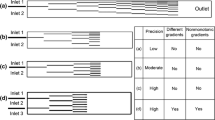Abstract
A GPU-enabled design framework is presented to automate the global optimization process of microfluidic concentration gradient generators (µCGGs). The optimization finds operational parameters (inlet concentrations and pressures) of CGGs to produce desired/prescribed concentration gradient (CG) profiles. To enhance optimization speed, the physics-based component model (PBCM) in the closed form is employed for simulation in lieu of the expensive CFD model. A genetic algorithm (GA) including the migration to mitigate the pre-maturation issue is developed. A new approach to include a penalty term that minimizes pressure non-uniformity in CGGs and the chance of violating physical assumptions used by PBCM is proposed. The entire process of PBCM evaluation and GA optimization is implemented on the GPU platform to utilize its massive computing parallelization. Two different laminar flow diffusion-based microfluidic CGGs: triple-Y and double-Ψ are used to verify the framework. Various shapes of desired CGs are examined for triple-Y and double-Ψ, and the average mean relative errors between the optimal designs and desired CGs are found to be 3.85% and 3.97%, respectively. The optimization is completed within 150 s on a GPGPU workstation and within 25 min on a GPU-embedded, small form-factor edge computing device, leading to about 130 × and 11–12 × speedup over the CPU process, respectively. The present research for the first time demonstrates the potential of applying microfluidic design automation on the edge-computing platform in laboratory environments.








Similar content being viewed by others
References
Irimia D (2010) Microfluidic technologies for temporal perturbations of chemotaxis. Annu Rev Biomed Eng 12:259–284
Kothapalli CR, Van Veen E, De Valence S, Chung S, Zervantonakis IK, Gertler FB, Kamm RD (2011) A high-throughput microfluidic assay to study neurite response to growth factor gradients. Lab Chip 11(3):497–507
Nandagopal S, Wu D, Lin F (2011) Combinatorial guidance by CCR7 ligands for T lymphocytes migration in co-existing chemokine fields. PLoS ONE 6(3):e18183
Guo Y, Gao Z, Liu Y, Li S, Zhu J, Chen P, Liu BF (2020) Multichannel synchronous hydrodynamic gating coupling with concentration gradient generator for high-throughput probing dynamic signaling of single cells. Anal Chem 92(17):12062–12070
Toh AG, Wang ZP, Yang C, Nguyen NT (2014) Engineering microfluidic concentration gradient generators for biological applications. Microfluid Nanofluid 16(1):1–18
Wang H, Chen CH, Xiang Z, Wang M, Lee C (2015) A convection-driven long-range linear gradient generator with dynamic control. Lab Chip 15(6):1445–1450
Xu Z, Huang X, Wang P, Wang H, Weitz DA (2016) Optimization and development of a universal flow-based microfluidic gradient generator. Microfluid Nanofluid 20(6):89
Hu C, Liu J, Chen H, Nie F (2017) Microfluidic platforms for gradient generation and its applications. Biochem Anal Biochem 6(320):2161
Wang X, Liu Z, Pang Y (2017) Concentration gradient generation methods based on microfluidic systems. RSC Adv 7(48):29966–29984
Oh KW, Lee K, Ahn B, Furlani EP (2012) Design of pressure-driven microfluidic networks using electric circuit analogy. Lab Chip 12(3):515–545
Li Y, Chen D, Zhang Y, Liu C, Chen P, Wang Y, Liu BF (2016) High-throughput single cell multidrug resistance analysis with multifunctional gradients-customizing microfluidic device. Sens Actuators B Chem 225:563–571
Shi H, Hou Z, Zhao Y, Nie K, Dong B, Chao L, Liu Z (2019) Rapid and steady concentration gradient generation platform for an antimicrobial susceptibility test. Chem Eng J 359:1327–1338
Hong SH, Yang H, Wang Y (2020) Inverse design of microfluidic concentration gradient generator using deep learning and physics-based component model. Microfluid Nanofluid 24(6):1
Zhou Y, Wang Y, Mukherjee T, Lin Q (2009) Generation of complex concentration profiles by partial diffusive mixing in multi-stream laminar flow. Lab Chip 9(10):1439–1448
Vozzi G, Mazzei D, Tirella A, Vozzi F, Ahluwalia A (2010) Finite element modelling and design of a concentration gradient generating bioreactor: application to biological pattern formation and toxicology. Toxicol In Vitro 24(6):1828–1837
Gao Y, Sun J, Lin WH, Webb DJ, Li D (2012) A compact microfluidic gradient generator using passive pumping. Microfluid Nanofluid 12(6):887–895
Chen X, Hu Z, Zhang L, Yao Z, Chen X, Zheng Y, Song H (2017) Numerical and experimental study on a microfluidic concentration gradient generator for arbitrary approximate linear and quadratic concentration curve output. Int J Chem React Eng 16(1):20160204
Hu Z, Chen X, Wang L (2018) Design and fabrication of concentration-gradient generators with two and three inlets in microfluidic chips. Chem Eng Technol 41(3):489–495
Wang Y, Mukherjee T, Lin Q (2006) Systematic modeling of microfluidic concentration gradient generators. J Micromech Microeng 16(10):2128
Friedrich D, Please CP, Melvin T (2012) Design of novel microfluidic concentration gradient generators suitable for linear and exponential concentration ranges. Chem Eng J 193:296–303
Yang H, Hong SH, ZhG R, Wang Y (2020) Surrogate-based optimization with adaptive sampling for microfluidic concentration gradient generator design. RSC Adv 10(23):13799–13814
Fernandes DL, Paun C, Pavliuk MV, Fernandes AB, Bastos EL, Sá J (2016) Green microfluidic synthesis of monodisperse silver nanoparticles via genetic algorithm optimization. RSC Adv 6(98):95693–95697
Cairone F, Anandan P, Bucolo M (2018) Nonlinear systems synchronization for modeling two-phase microfluidics flows. Nonlinear Dyn 92(1):75–84
Arun Sankar EM, Shahab M, Rengaswamy R (2021) Spacing optimization for active droplet sorting in microfluidic networks using genetic algorithm. Ind Eng Chem Res 60(4):1699–1708
Stoecklein D, Davies M, Wubshet N, Le J, Ganapathysubramanian B (2017) Automated design for microfluid flow sculpting: multiresolution approaches, efficient encoding, and CUDA implementation. J Fluids Eng 139(3):031402
Izzo D, Ruciński M, Biscani F (2012) The generalized island model. In: Parallel architectures and bioinspired algorithms. Springer, Berlin, Heidelberg, Berlin, Heidelberg
Bejan A (2013) Convection Heat Transfer, 4th edn. Wiley, Hoboken
Funding
Not applicable.
Author information
Authors and Affiliations
Corresponding author
Ethics declarations
Conflict of interest
On behalf of all authors, the corresponding author states that there is no conflict of interest.
Additional information
Publisher's Note
Springer Nature remains neutral with regard to jurisdictional claims in published maps and institutional affiliations.
Rights and permissions
About this article
Cite this article
Hong, S.H., Shu, JI., Ou, J. et al. GPU-enabled microfluidic design automation for concentration gradient generators. Engineering with Computers 39, 1637–1652 (2023). https://doi.org/10.1007/s00366-021-01548-8
Received:
Accepted:
Published:
Issue Date:
DOI: https://doi.org/10.1007/s00366-021-01548-8




